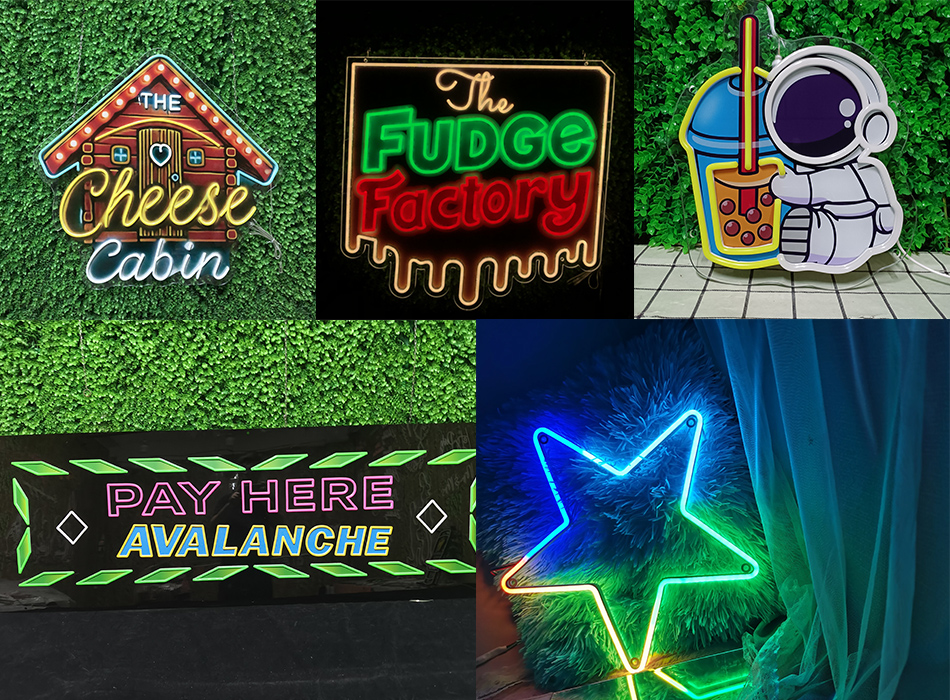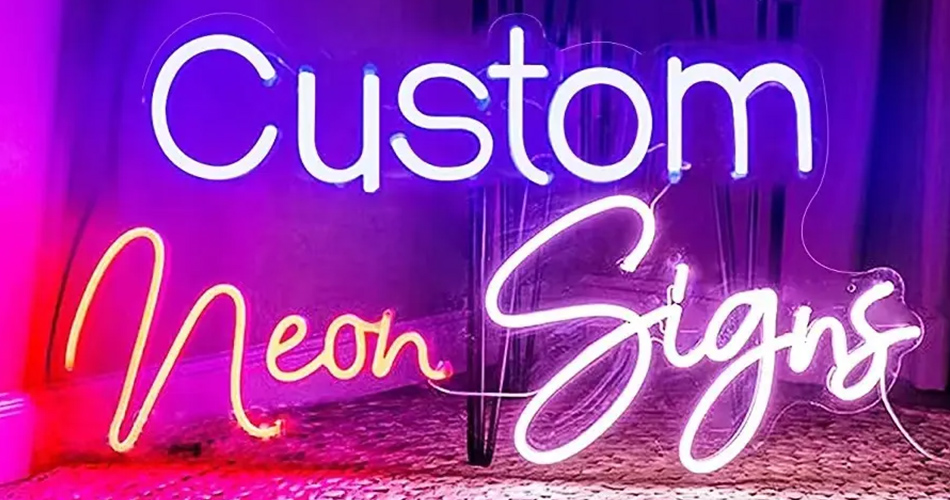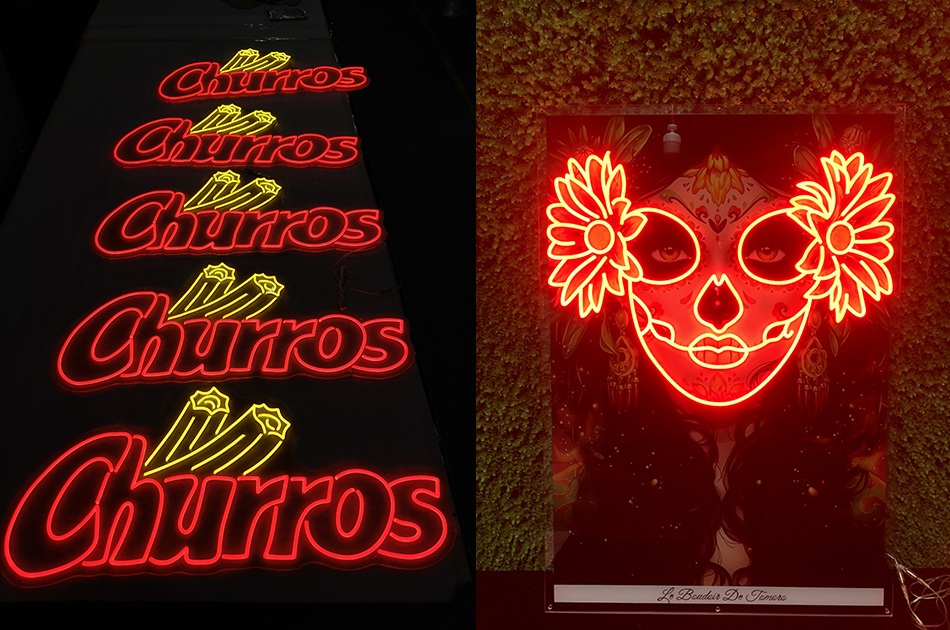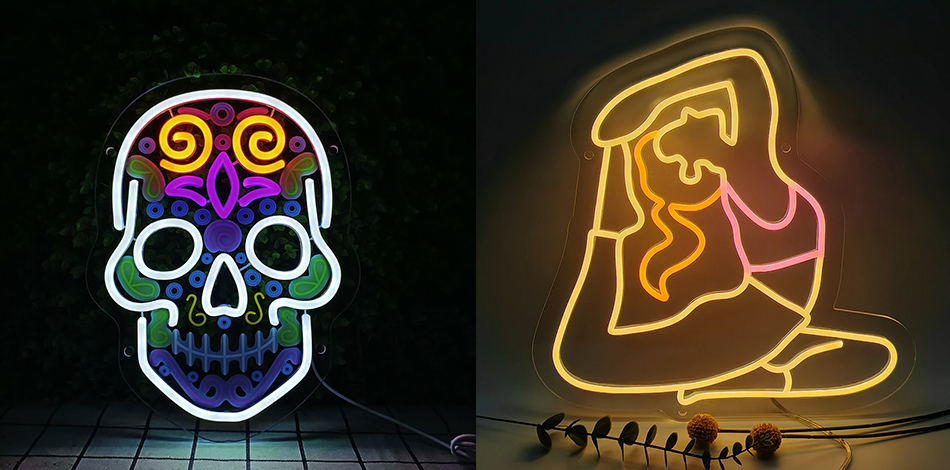Time:2025-07-12
Custom Neon Signs: Illuminating Creativity and Brand Identity
In the ever-evolving landscape of visual communication and design, custom neon signs have carved out a unique niche, captivating audiences with their luminous glow and artistic versatility. These signs transcend the realm of mere lighting fixtures, serving as powerful tools for brand expression, interior enhancement, and event decoration. From the bustling storefronts of urban centers to the intimate corners of private spaces, custom neon signs bring a touch of magic and individuality to any environment.

A Historical Perspective: The Evolution of Neon Signs
The history of neon signs dates back to the early 20th century when Georges Claude, a French engineer, introduced the first neon lamp to the public in 1910. Initially used primarily for advertising purposes, neon signs quickly gained popularity due to their bright, eye-catching glow and ability to stand out in crowded cityscapes. Over the years, advancements in technology and manufacturing techniques have expanded the possibilities of neon sign design, leading to the creation of custom neon signs that cater to a wide range of needs and preferences.
Traditional neon signs were crafted by hand-bending glass tubes and filling them with noble gases, such as neon or argon. When an electric current passed through the gas, it emitted a characteristic glow, creating a vibrant and distinctive lighting effect. While this method of production offered a high level of craftsmanship and artistic expression, it also had limitations in terms of cost, durability, and customization flexibility.
The advent of LED technology in recent decades has revolutionized the neon sign industry. LED neon signs offer numerous advantages over traditional glass neon, including energy efficiency, longer lifespan, greater durability, and enhanced customization capabilities. Today, custom neon signs can be created using a combination of traditional glass neon techniques and modern LED technology, providing designers and clients with the best of both worlds.

Technical Foundations: How Custom Neon Signs are Made
Glass Neon Sign Manufacturing
Tube Bending: The process of creating a traditional glass neon sign begins with the bending of glass tubes. Skilled artisans use specialized tools and techniques to heat the glass and shape it into the desired form, whether it's a simple letter, a complex logo, or an intricate design. The glass tubes are typically made of borosilicate glass, which is resistant to thermal shock and can withstand the high temperatures involved in the bending process.
Gas Filling: Once the glass tubes are bent into the desired shape, they are filled with a noble gas, such as neon or argon. The gas is introduced into the tubes under high pressure, and electrodes are sealed at each end to complete the circuit. When an electric current is applied, the gas ionizes and emits a glow, creating the characteristic neon light.
Color Creation: Different colors in glass neon signs are achieved by adding metal salts or phosphor coatings to the glass tubes. For example, a neon-filled tube emits a red glow, while argon with a mercury vapor and a phosphor coating can produce blue or green light. By using a combination of different gases and coatings, a wide range of colors and effects can be created.
LED Neon Sign Manufacturing
LED Neon Flex: LED neon signs are typically made using LED neon flex, a flexible strip that contains surface-mounted LEDs encased in a protective material, such as silicone or PVC. The LED neon flex is highly flexible and can be bent and shaped into a variety of forms, making it ideal for creating custom designs.
Circuit Design and Assembly: The LEDs in the neon flex are connected in a circuit, which is designed to provide a constant and stable power supply. The circuit is typically controlled by a driver, which regulates the current and voltage to ensure the LEDs operate at their optimal performance. The LED neon flex is then assembled onto a backing or frame, which provides support and protection for the sign.
Control Systems: Many LED neon signs are equipped with advanced control systems that allow for precise adjustment of brightness, color, and lighting effects. These control systems can be operated using remote controls, mobile apps, or smart home systems, providing users with convenient and flexible ways to manage the lighting.

The Design Process: Translating Ideas into Light
Concept Development
The first step in creating a custom neon sign is to develop a concept. This involves working closely with the client to understand their vision, goals, and requirements for the sign. Whether it's a branding project, an interior design element, or an event decoration, the concept should reflect the client's personality and style.
During the concept development phase, designers may explore a variety of design elements, such as color, shape, font, and lighting effects, to create a unique and visually appealing sign. They may also consider the intended location and audience for the sign, as well as any specific technical requirements or constraints.
Sketching and Visualization
Once the concept is developed, designers begin the process of sketching out initial ideas for the neon sign. This stage involves translating the concept into visual elements, using digital design tools or traditional drawing techniques. The sketches may include rough outlines, color studies, and detailed renderings of the sign, providing the client with a clear understanding of the design direction.
In addition to the visual design, designers also consider the technical aspects of the sign, such as the size, shape, and placement of the neon tubes or LED neon flex. They may create 3D models or mock-ups of the sign to visualize how it will look in the intended location and to ensure that it meets the client's expectations.
Material Selection and Customization
The choice of materials for a custom neon sign is crucial for both its appearance and performance. In addition to the neon tubes or LED neon flex, other materials used may include the backing or frame of the sign, as well as any additional elements, such as diffusers, reflectors, or mounting hardware.
The backing or frame of the sign can be made from a variety of materials, such as metal, wood, acrylic, or PVC, depending on the desired aesthetic and the environment in which the sign will be installed. The material should be durable, lightweight, and easy to install, while also providing support and protection for the neon tubes or LED neon flex.
Customization options for neon signs are virtually limitless. Clients can choose from a wide range of colors, fonts, shapes, and lighting effects to create a sign that is truly unique and tailored to their specific needs. Some signs may also include additional features, such as animation, motion sensors, or sound integration, to enhance the visual impact and interactivity of the sign.

Diverse Applications of Custom Neon Signs
Commercial Signage
Storefronts and Retail Displays: Custom neon signs are a popular choice for storefronts and retail displays, as they can effectively attract customers and enhance brand visibility. A well-designed neon sign can make a store stand out from the competition, drawing the attention of passersby and enticing them to enter. Neon signs can also be used to display store names, logos, products, or promotions, providing a clear and concise message to customers.
Restaurants and Bars: In the hospitality industry, custom neon signs play a crucial role in creating a unique and inviting atmosphere. They can be used to highlight the name and logo of the restaurant or bar, as well as to display menu items, special offers, or themed decorations. Neon signs can also be used to create a focal point or a statement piece in the interior design, adding a touch of style and personality to the space.
Hotels and Resorts: Custom neon signs can enhance the branding and ambiance of hotels and resorts, creating a memorable and luxurious experience for guests. They can be used to display the hotel or resort name, logo, or tagline, as well as to provide wayfinding information or decorative accents. Neon signs can also be used in guest rooms, lobbies, restaurants, and other public areas to add a touch of elegance and sophistication to the space.
Interior Design
Home Decor: Custom neon signs are increasingly popular in home decor, as they can add a unique and personalized touch to any room. They can be used to create a focal point or a statement piece in the living room, bedroom, kitchen, or bathroom, adding a touch of style and personality to the space. Neon signs can also be used to display inspirational quotes, artwork, or family names, creating a warm and inviting atmosphere in the home.
Office Spaces: In the workplace, custom neon signs can be used to enhance the branding and culture of the company, creating a positive and productive work environment. They can be used to display the company name, logo, or mission statement, as well as to provide motivational messages or decorative accents. Neon signs can also be used in break rooms, conference rooms, or reception areas to add a touch of creativity and innovation to the space.
Art Galleries and Museums: Custom neon signs can be used in art galleries and museums to display artwork, create a unique atmosphere, or provide information to visitors. They can be used to highlight the name and logo of the gallery or museum, as well as to display exhibition titles, artist names, or descriptive text. Neon signs can also be used as standalone art pieces, adding a contemporary and dynamic element to the exhibition space.
Event Decoration
Weddings and Celebrations: Custom neon signs are a popular choice for weddings and other celebrations, as they can add a romantic and festive touch to the event. They can be used to display the couple's names, wedding date, or a special message, creating a personalized and memorable atmosphere for the guests. Neon signs can also be used to decorate the ceremony, reception, or photo booth area, adding a touch of style and elegance to the event.
Corporate Events and Conferences: In the corporate world, custom neon signs can be used to enhance the branding and visibility of the event, creating a professional and engaging atmosphere for the attendees. They can be used to display the event name, logo, or theme, as well as to provide wayfinding information or decorative accents. Neon signs can also be used in the exhibition hall, conference room, or networking area to add a touch of creativity and innovation to the event.
Festivals and Concerts: Custom neon signs can be used in festivals and concerts to create a vibrant and energetic atmosphere, attracting the attention of the audience and enhancing the overall experience. They can be used to display the event name, logo, or lineup, as well as to provide wayfinding information or decorative accents. Neon signs can also be used as stage backdrops, adding a dynamic and visually stunning element to the performance.

Installation and Maintenance
Professional Installation
Installing a custom neon sign requires technical expertise and careful attention to detail. Professional installers are trained to handle the electrical components safely and ensure that the sign is securely mounted. They will also take into account factors such as the electrical supply, wiring concealment, and the structural integrity of the mounting surface.
For outdoor installations, additional considerations include proper grounding to prevent electrical hazards and ensuring that the sign is installed at the right height and angle for optimal visibility. Professional installers can also provide advice on the best placement of the sign to maximize its impact.
Routine Maintenance
To ensure the longevity and optimal performance of custom neon signs, regular maintenance is essential. This includes cleaning the sign periodically to remove dust, dirt, and fingerprints, which can affect its brightness and appearance. A soft, dry cloth or a gentle cleaning solution specifically designed for neon or LED surfaces can be used for cleaning.
It's also important to regularly inspect the sign for any signs of damage, such as loose connections, cracked tubes, or malfunctioning LEDs. Promptly addressing any issues can prevent further damage and ensure that the sign continues to operate smoothly. Some custom neon signs may also require occasional software updates for the control system to maintain compatibility with new devices or to access new features.
Choosing the Right Provider
When investing in a custom neon sign, selecting a reliable and experienced provider is crucial. A good provider will have a portfolio of high-quality work, positive customer reviews, and a team of skilled designers and technicians. They should be able to guide the client through the entire process, from the initial design concept to the final installation and after-sales support.
It's also important to consider factors such as the provider's warranty policy, turnaround time, and pricing. While cost is a consideration, it should not be the sole determining factor. Choosing a provider that offers a balance of quality, service, and affordability will ensure that the custom neon sign meets the client's expectations and provides long-term value.
The Future of Custom Neon Signs
As technology continues to evolve, the future of custom neon signs looks promising. Advancements in LED technology are likely to lead to even more energy-efficient, brighter, and more color-accurate neon signs. Integration with smart technologies, such as the Internet of Things (IoT) and artificial intelligence (AI), may enable more sophisticated control and automation of the signs, allowing for seamless integration with other systems and devices.
Furthermore, the increasing demand for sustainable and eco-friendly solutions in the design and construction industry may drive the development of custom neon signs made from recycled or biodegradable materials. This would not only reduce the environmental impact but also appeal to the growing number of environmentally conscious consumers.
In conclusion, custom neon signs offer a unique and versatile way to enhance brand identity, create a memorable atmosphere, and add a touch of creativity and personality to any space. Whether it's for commercial, residential, or event applications, custom neon signs have the power to transform ordinary environments into extraordinary experiences. By understanding the technical aspects, design process, applications, and maintenance requirements of these signs, clients can make informed decisions and create custom neon signs that exceed their expectations.